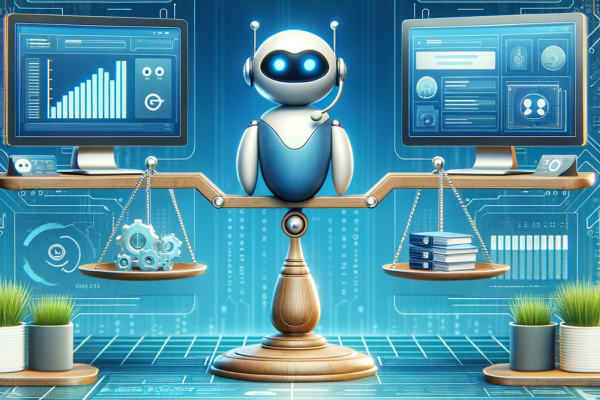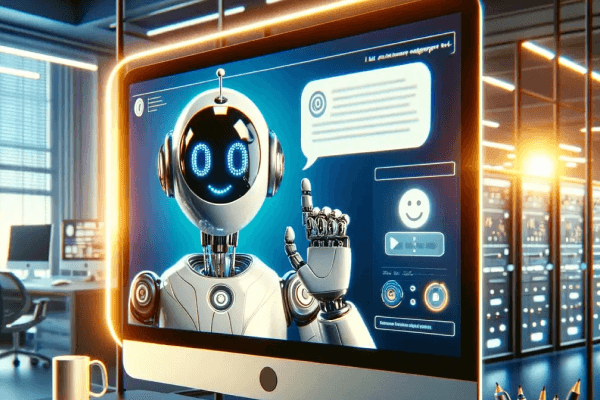AI chatbots can save businesses up to 30% on customer service costs by automating routine tasks, reducing staffing needs, and ensuring 24/7 support. Here’s how they help:
- Handle repetitive questions: Automate FAQs, cutting operational costs by up to 75%.
- Lower staffing expenses: Manage up to 80% of inquiries without human agents.
- Provide 24/7 availability: Offer round-the-clock service without extra shifts.
- Manage high-volume periods: Handle unlimited inquiries during busy times.
- Boost team efficiency: Pre-qualify inquiries and assist agents with instant resources.
- Reduce tech setup costs: Lower implementation and operational expenses.
- Expand self-service options: Empower customers to resolve issues independently.
For example, TechStyle Fashion Group saved $1.1 million, and Bank of America’s Erica handled 1.5 billion interactions, drastically cutting costs. With the chatbot market projected to reach $1.25 billion by 2025, AI tools are transforming customer support while keeping budgets lean.
AI Chatbots in Modern Customer Support
AI chatbots are reshaping customer support by tackling complex tasks and significantly reducing costs. Unlike human agents, who can typically manage around three interactions at a time, chatbots handle multiple conversations simultaneously, making them a cost-effective solution.
Here are some real-world examples of businesses benefiting from AI chatbots:
- HelloSugar: Automated 66% of customer queries, saving $14,000 monthly. This allowed them to grow from 81 to 160 locations without adding reception staff.
- Lush: Cut ticket handling time by 5 minutes per ticket, saving 360 agent hours each month.
- Photobucket: Answered 94% of common questions instantly, with 10% of conversations fully resolved without human intervention.
"We currently have 81 salons and are going to grow to 160 this year – without growing our reception staff. And with automation, we’re able to do that while offering way better CX and getting higher reviews."
– Austin Towns, Chief Technology Officer at Hello Sugar [4]
Key Features That Reduce Costs
- 24/7 Availability: Chatbots provide round-the-clock support without the need for extra staffing.
- Multi-Channel Support: Ensure seamless interactions across various digital platforms.
- Instant Responses: Meet the expectations of 77% of customers who demand immediate interaction [8].
- Data Integration: Access backend systems for personalized and efficient support.
- Language Support: Handle multiple languages without hiring additional staff.
The financial impact is clear – companies can cut customer service costs by up to 30% with chatbots [5]. With operational costs being so low, chatbots are often only a portion of a single employee’s annual salary while managing unlimited interactions [6].
"There is a predictable and reliable component of chatbots. They never tire, do not call in sick, and if designed correctly are consistent and exacting."
– Joe Gagnon, Chief Customer Officer of Aspect Software [6]
1. Handle Common Questions Automatically
AI chatbots are excellent at tackling repetitive customer questions, offering quick and efficient automated responses. They respond in under 6 seconds – much faster than the 2-minute average for human agents [9].
FAQ chatbots can cut operational costs by as much as 75% [10], managing multiple conversations at once while maintaining consistent quality.
Success Stories in Healthcare
The healthcare industry provides great examples of how automated inquiry handling can make a difference:
- Northwell Health reduced call center traffic by 50% by automating appointment scheduling and basic patient inquiries [11].
- Premera Blue Cross introduced a chatbot to help members compare procedure costs at different facilities, leading to better decisions and fewer support calls [11].
- Mayo Clinic created a surgical journey bot to address pre- and post-operative questions, easing the workload of medical staff [11].
These examples highlight how automation can transform customer support.
Tips for Effective Implementation
-
Prioritize High-Volume Questions
AI chatbots can handle up to 80% of support tickets [7], especially useful during busy times when human agents are stretched thin. -
Maintain Accuracy and Build Trust
Regularly review automated responses to ensure they’re accurate and reliable. For example:"AI Drafts have made Whole Company Support feel a lot less daunting. Our support team always encourages everyone to fact-check and revise drafts so they’re written in their own voice, but we’ve found this gives them a great jumping-off point."
– Kristi Ernst Thompson, Senior Technical Support Specialist, Help Scout [3] -
Track Key Metrics
Monitor performance indicators like resolution rates and response accuracy. For instance, a midsize airline achieved an 80% containment rate and 90% accuracy while managing 1,200 weekly interactions [12].
Best Questions to Automate
| Query Type | Automation Benefits |
|---|---|
| New Customer Queries | Customer can quickly get answers and see value in your product/service |
| Shipping Policies | Clear and consistent communication |
| Product Questions | Product information and comparisons can be provided to the customer instantly to increase the chance they purchase. |
2. Lower Staff Costs
AI chatbots help businesses save on support costs by reducing the need for large support teams. Companies currently spend around $1.3 trillion annually addressing 265 billion customer requests [5]. By integrating AI tools, businesses can cut expenses significantly without sacrificing service quality. The savings are clear when looking at key performance metrics.
Measurable Cost Savings
AI-powered support systems can lower service costs by up to 40% [13]. They achieve this by managing as much as 80% of routine inquiries without needing human agents [13].
| Cost Component | Traditional Support | AI-Enhanced Support |
|---|---|---|
| Monthly Agent Cost | $3,873 per agent | $100-$5,000 total for chatbot |
| Query Resolution | 1 agent per conversation | Multiple simultaneous chats |
| Operating Hours | Limited by shifts | 24/7 availability |
Real-World Examples
Take Bank of America’s AI assistant, Erica – it has successfully handled over 1.5 billion customer interactions, saving millions in staffing expenses [13]. Another example is Lyft, which adopted the AI-powered assistant Claude. This move slashed resolution times by 87% [13], enabling the company to operate with a leaner support team.
These examples highlight how AI can drive efficiency and reduce costs without compromising service.
Tips for Implementation
- Analyze current costs: Focus on automating repetitive, high-volume tasks to maximize savings [5].
- Track performance: Monitor metrics like resolution rates and response times to ensure service levels remain high.
According to McKinsey, generative AI can boost customer service productivity by up to 45% [14]. Additionally, businesses typically report a 9% decrease in complaint resolution time after adopting AI [14]. These improvements allow companies to maintain top-notch service while keeping teams smaller and more efficient.
3. Offer 24/7 Support Cost-Effectively
Running a traditional 24/7 support team means juggling multiple shifts, paying overtime, and dealing with skyrocketing costs. AI chatbots, on the other hand, provide round-the-clock service without adding to your overhead.
By automating responses to common inquiries, chatbots not only save money but also make 24/7 support far more affordable.
Cost Comparison Analysis
| Support Type | Traditional 24/7 Team | AI Chatbot Solution |
|---|---|---|
| Monthly Cost | $11,619 (3 agents × $3,873) | $100-$5,000 |
| Coverage Hours | 3 shifts needed | One platform |
| Holiday Coverage | Premium pay required | No additional cost |
| Simultaneous Inquiries | 1 per agent | Unlimited |
This table makes it clear: chatbots are a budget-friendly alternative to traditional support teams.
Measurable Business Impact
One telecom company boosted employee productivity by 3.5X and reduced hotline calls by 50% using 24/7 chatbot support [5]. That’s a major improvement in both efficiency and customer experience.
Industry-Specific Benefits
For e-commerce businesses, which collectively spend about $1.3 trillion annually on customer inquiries, chatbots can cut costs by around 30%. This is especially helpful for companies operating across multiple time zones [15].
"While self-automation has been happening for a while in the software space, this trend will become more present internally in customer service because reps now have improved access to automation tools" [1].
Implementation Guidelines
To get the most out of chatbot support while keeping service quality high:
- Ensure information provided to the AI is accurate.
- Set up clear processes for escalating complex issues to human agents, using AI to improve the customer experience, not as a deflection tactic.
- Track key metrics like resolution rates and response times to ensure performance stays on track.
sbb-itb-bd61b1a
4. Manage High-Volume Periods
During busy times, support teams often face a flood of inquiries. AI chatbots can handle as many conversations as needed at once, removing the need to hire temporary staff.
Scaling Without Extra Costs
Human agents can only manage one conversation at a time, but AI chatbots can handle an unlimited number simultaneously. This makes them particularly useful during major sales or campaigns when inquiry volumes spike.
Success Stories in Action
Tryg Insurance, the second-largest non-life insurer in the Nordics, shows how effective AI chatbots can be. Their chatbot achieved up to a 95% automation rate, serving nearly 4 million customers with ease [16].
Cost Breakdown for Peak Times
| Aspect | Traditional Scaling | AI Chatbot Scaling |
|---|---|---|
| Monthly Cost | $600–$5,000 per temporary agent | $0–$500 (standard) or $600–$5,000 (enterprise) |
| Conversation Capacity | 1 per agent | Unlimited |
| Response Time | Variable | Instant |
Smarter Efficiency with Routing
Modern AI chatbots can sort and direct inquiries based on urgency and topic. This ensures human agents focus on complex problems while routine questions get instant answers. For instance, MSU Federal Credit Union automated 2,000 employee-to-employee interactions each month, greatly improving efficiency [16].
To get the most out of AI chatbots during high-demand periods, businesses should:
- Automate frequently asked questions.
- Automate simple question-and-answer type questions.
- Use an AI solution as the default answer-provider for the customer, to encourage it to be used, with a back up of escalation to a human if needed or if the AI cannot answer.
- Track performance metrics to fine-tune accuracy.
Next, discover how AI chatbots can take support team productivity to the next level.
5. Boost Support Team Output
AI chatbots are not just for handling high-volume periods – they also help support teams work more efficiently. By automating repetitive tasks, chatbots let agents focus on solving more challenging customer issues.
Smart Routing and Information Collection
AI chatbots can gather essential details and pre-qualify customer inquiries before passing them to a live agent. This ensures requests are directed to the right person quickly, keeping service levels high.
Agent Assistance Tools
Today’s AI tools provide direct support to agents, offering features like:
| Feature | Benefit |
|---|---|
| Instant Knowledge | Reduces time spent searching for documentation |
| Suggested Responses | Speeds up crafting replies |
| Multi-Language Support | Simplifies communication across languages |
These tools significantly improve team efficiency and reduce operational costs.
Real-World Efficiency Gains
Examples of AI in action include TransferGo‘s multilingual virtual agent, which tackles routine inquiries, and Delta Airlines’ AI, which slashes hold times from minutes to mere seconds.
"People go on and are on hold for five minutes waiting for an answer; they should only be on hold for five seconds. That’s what AI can do, and that’s one of the first applications that we’re deploying." [3]
Measuring Productivity Improvements
To understand how AI impacts productivity, businesses can track metrics like:
- Chatbot conversation duration to measure time saved
- Number of questions resolved per interaction
- Self-service success rates
- Usage trends during different times of day
One standout example is The Ottawa Hospital. Its AI system minimizes administrative tasks for medical staff, ensuring patients receive accurate, consistent information. This allows healthcare professionals to dedicate more time to direct patient care instead of paperwork [17].
These advancements not only improve efficiency but also pave the way for cost savings and better operations.
6. Cut Tech Setup Costs
AI chatbots don’t just boost team efficiency – they also help businesses save big on tech setup costs. Traditional customer support systems require hefty upfront investments in hardware, software, and staffing. In contrast, AI chatbots offer a more affordable solution with pricing models that cater to businesses of all sizes.
To put this into perspective: resolving an issue with a live agent costs between $5 and $35 per call, while virtual agents can handle the same interactions for as little as $0.30 – or even $0.05 in high-volume, simple scenarios [19].
Implementation Cost Comparison
| Solution Type | Initial Setup Cost | Monthly Operating Cost |
|---|---|---|
| AI Chatbot (subscription) | $0 | $0.05-0.30 per interaction |
| Rule-Based Chatbot (Agency) | $15,000 – $30,000 | $0.05-0.30 per interaction |
| AI Chatbot (Agency) | $75,000 – $150,000 | $0.05-0.30 per interaction |
| Custom In-house Development | $100,000 – $200,000 | Internal team costs |
| Traditional Call Center | Hardware + Training + Staff | $5–$35 per interaction |
This table underscores how AI-powered solutions can significantly lower costs compared to traditional methods.
Real-World Success Stories
A great example of cost savings comes from the London Borough of Barking and Dagenham. Their AI assistant, used across multiple departments, saved them approximately £48,000 in just six months. On top of that, customer satisfaction increased by 67% [18].
These results show how AI chatbots can deliver both financial savings and better customer experiences.
Choosing the Right Solution
Modern chatbot platforms come with scalable pricing options. For small businesses, costs can range from $0 to $500 per month, while larger enterprises might pay between $1,000 and $10,000, depending on features and usage volume.
"I would add that many people think they can do it themselves, so projects are run by IT with little thought of CX. Yes, this solution might work, and yes, it also might scale… But customers simply don’t like it for whatever reason. Usually, conversation design is an afterthought!" – Ted Franz, VP of Sales and Partnerships, Master of Code Global [18]
Future Cost Implications
Gartner predicts that Conversational AI will save businesses a staggering $80 billion in contact center costs by 2026 [18]. These savings will come from reduced infrastructure needs, lower training expenses, less reliance on physical office space, automatic scalability, and built-in maintenance and updates.
7. Expand Self-Help Options
AI chatbots are transforming customer self-service, allowing businesses to handle support inquiries at a fraction of the cost of traditional methods. Research indicates that resolving queries through self-service is 80 to 100 times cheaper than using live support agents [21].
How Self-Service Reduces Costs
The numbers speak for themselves – 70% of customers already rely on self-service portals to solve their issues [21]. Adding AI-driven tools can cut ticket volumes by up to 30% in just a few months [20]. This reduction not only saves money but also improves operational efficiency.
For instance, a European logistics company working with SMC Consulting saw a 52% drop in ticket volume, a 65% boost in employee satisfaction, and freed up 20 hours each week for other projects [20]. Expanding self-service also means ensuring language support to cater to a broader audience.
Multilingual Support Made Simple
Take TransferGo as an example. Their virtual agent manages self-service in 11 languages and updates customer details in seven – without the need for additional staff [3].
Smarter Knowledge Bases
Delta Airlines has integrated AI into its knowledge base to provide quick access to critical information, significantly cutting response times. Delta Airlines CEO Ed Bastian shared:
"We’re working with our reservations team to try to help our reservations agents parse the historical policies and questions and things that you may call into a real agent… People go on and are on hold for five minutes waiting for an answer; they should only be on hold for five seconds. That’s what AI can do, and that’s one of the first applications that we’re deploying." [3]
Key Metrics for Self-Service Success
| Metric | Impact |
|---|---|
| Customer Preference | 40% of users prefer self-service over contacting support [20] |
| Issue Resolution | 80% of routine questions are handled by chatbots [21] |
| Churn Prevention | 67% of customer churn can be avoided with first-time resolution [22] |
| Industry Adoption | 80% of companies use chatbots, with 36% planning AI adoption next year [23] |
In one standout case, a major telecommunications provider used AI chatbots to handle 73% of all customer transactions [23].
"AI-powered self-service offers a distinct competitive edge. By reducing ticket volumes and empowering users, your business can achieve faster resolutions, happier stakeholders, and a leaner budget." – SMC Consulting [20]
Available Tools and Results
Resolve247.ai offers two standout tools – AIChatbot and ResponseAssistant – to help businesses cut down on support costs using AI.
- AIChatbot is an AI that your customers interact with directly – to provide instant accurate solutions and reducing volume of incoming queries.
- ResponseAssistant is an AI that drafts responses in your inbox – so your team can respond to the queries quicker and with less effort.
Affordable AI Solutions
The AIChatbot starts at just $14/month. To put this into perspective, the average customer service rep earns $3,873/month [7]. Resolve247.ai’s Ultimate plan, priced at $349/month, can handle up to 50,000 customer inquiries – taking on the workload of several full-time agents for a fraction of the cost.
Features That Save Money
| Feature | How It Saves Money |
|---|---|
| 24/7 Availability | Removes the need for night shift staffing |
| Auto Knowledge Top-Up | Cuts down on training and documentation time |
| Automatic Translation | Reduces costs for multilingual support |
| Historical Chat Audit | Reviews queries to spot patterns, so you can address issues |
Proven Performance
Resolve247.ai’s AIChatbot reduces support tickets by 45-80%. These reductions directly lower operational expenses by decreasing the workload for human agents.
Scalable Pricing Options
ResponseAssistant offers flexible plans to meet different business needs:
- Starter: 100 AI drafts/month, ideal for small teams.
- Growth: 300 AI drafts/month, tailored for growing businesses.
- Scale: 2,000 AI drafts/month, perfect for large-scale operations.
Seamless Integration
Resolve247.ai tools integrate smoothly with existing systems, so there’s no need for expensive platform changes or extra training. The platform ensures accurate responses, reducing escalations and improving customer satisfaction.
Founder Sam Cox designed features like automatic updates to the knowledge base, pre-drafted responses, and effortless human handovers – all aimed at cutting support costs while maintaining service quality.
Cost-Effective Results
Some other chatbot solutions cost anywhere from $500 to $5,000 per month [7]. Resolve247.ai provides enterprise-level functionality for much less, starting from just $14/month, up to the Ultimate plan delivering robust features for just $349/month [24]. This makes it an efficient and budget-friendly choice for modern support strategies.
AI Chatbots: A Game-Changer for Customer Service
AI chatbots are reshaping how businesses manage costs while maintaining high-quality service. According to recent data, companies using AI-driven virtual agents can cut customer service expenses by up to 30%, all while boosting customer satisfaction and loyalty [25].
By 2025, it’s predicted that 80% of customer service teams will rely on generative AI tools to improve both agent productivity and the overall customer experience [25]. One example comes from a U.S.-based wealth management firm, which removed 166,000 unnecessary calls thanks to AI, showcasing the large-scale impact of this technology [2].
Varma Pension Insurance provides another strong example. Their chatbot, Helmi, automated 85% of chat interactions, saving 330 hours each month and increasing service availability by 400% [26].
"The quality of our telephone customer service has changed; common issues are reduced, while calls requiring human expertise are dominating", said Tiina Kurki, Senior Vice-President of Pension Services and IT at Varma [26].
These examples highlight how automation can handle routine inquiries, reduce staffing needs, and ensure 24/7 availability – all contributing to significant cost savings.
Looking forward, AI is expected to manage 95% of customer interactions by 2025, further driving efficiency and cost reductions [27]. The global chatbot market is projected to exceed $1.34 billion, and McKinsey research shows that AI can improve efficiency by 40% while reducing operating costs by 30% [27]. These numbers emphasize the core takeaway: smart AI implementation improves both operational performance and customer satisfaction.
To make the most of AI chatbots, businesses need clear goals and strong data strategies. From automating routine questions to increasing support team productivity, chatbots offer scalable solutions for today’s customer service challenges. Regular performance reviews are key to balancing cost savings with excellent service. As customer expectations grow, AI chatbots remain a practical way to combine efficiency with an elevated customer experience.



